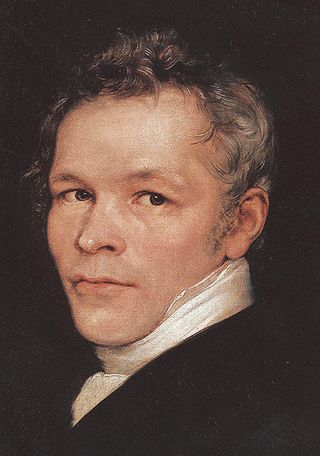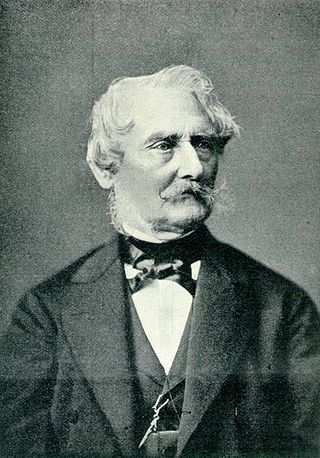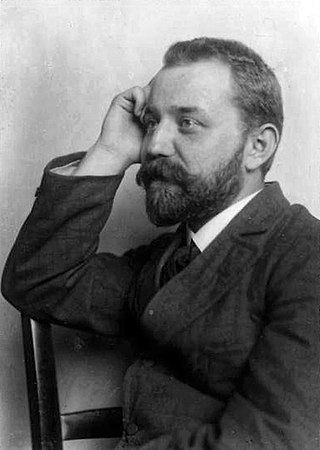
Karl Friedrich Schinkel was a Prussian architect, city planner and painter who also designed furniture and stage sets. Schinkel was one of the most prominent architects of Germany and designed both Neoclassical and neo-Gothic buildings. His most famous buildings are found in and around Berlin.

The Altes Museum is a listed building on the Museum Island in the historic centre of Berlin, Germany. Built between 1825 and 1830 by order of King Frederick William III of Prussia according to plans by Karl Friedrich Schinkel, it is considered a major work of German Neoclassical architecture. It is surrounded by the Berlin Cathedral to the east, the Berlin Palace to the south and the Zeughaus to the west. Currently, the Altes Museum houses the Antikensammlung and parts of the Münzkabinett. As part of the Museum Island complex, the Altes Museum was listed as a UNESCO World Heritage Site in 1999, in recognition of its testimony to the development of the museum as a social and architectural phenomenon.

The Berlin Observatory is a German astronomical institution with a series of observatories and related organizations in and around the city of Berlin in Germany, starting from the 18th century. It has its origins in 1700 when Gottfried Leibniz initiated the "Brandenburg Society of Science″ which would later (1744) become the Prussian Academy of Sciences. The Society had no observatory but nevertheless an astronomer, Gottfried Kirch, who observed from a private observatory in Berlin. A first small observatory was furnished in 1711, financing itself by calendrical computations.
The Konzerthausorchester Berlin is a German symphony orchestra based in Berlin. The orchestra is resident at the Konzerthaus Berlin, designed by the architect Karl Friedrich Schinkel. The building was destroyed during World War II, and was rebuilt from 1979 to 1984.

Glienicke Palace is a historic palace located on the peninsula of Berlin-Wannsee in Germany. It was designed by Karl Friedrich Schinkel around 1825 for Prince Carl of Prussia. Since 1990, Glienicke Palace and the park have been part of the UNESCO World Heritage Site "Palaces and Parks of Potsdam and Berlin" because of their unique contribution to Prussian landscape architecture.

The Invalids' Cemetery is one of the oldest cemeteries in Berlin. It was the traditional resting place of the Prussian Army, and is regarded as particularly important as a memorial to the German Wars of Liberation of 1813–15.

August Friedrich Wilhelm Orth was a German architect and designer.

Friedrich August Stüler was an influential Prussian architect and builder. His masterpiece is the Neues Museum in Berlin, as well as the dome of the triumphal arch of the main portal of the Berliner Schloss.

(Carl Heinrich) Eduard Knoblauch was a German architect.

Johann Heinrich Strack was a German architect of the Schinkelschule. His notable works include the Berlin Victory Column.

Johann August Karl Soller was a Prussian, and later, German architect. He was one of the most important of Karl Friedrich Schinkel's pupils and is regarded as a representative of the Schinkel school. Soller became an influential proponent of Rundbogenstil, a Romanesque revival architectural style that became popular in German-speaking lands and among German diaspora during the 19th century.

The Prussian National Monument for the Liberation Wars is a war memorial in Berlin, Germany, dedicated in 1821. Built by the Prussian king during the sectionalism before the Unification of Germany it is the principal German monument to the Prussian soldiers and other citizens who died in or else dedicated their health and wealth for the Liberation Wars (Befreiungskriege) fought at the end of the Wars of the Sixth and in that of the Seventh Coalition against France in the course of the Napoleonic Wars. Frederick William III of Prussia initiated its construction and commissioned the Prussian Karl Friedrich Schinkel who made it an important piece of art in cast iron, his last piece of Romantic Neo-Gothic architecture and an expression of the post-Napoleonic poverty and material sobriety in the liberated countries.

Ludwig Wilhelm Wichmann was a German sculptor. He specialized in making portrait busts.

The Schloss Tegel or Humboldt-Schloss is a country house in Tegel, part of the Reinickendorf district of the German capital Berlin. The brothers Wilhelm and Alexander von Humboldt spent much of their childhood in a former schloss on the site and on the estate, which extends almost as far as Lake Tegel.

The Luisenkirche is a Protestant municipal and parish church in Charlottenburg, now part of Berlin, Germany. The original building in Baroque style was begun in 1710, and around 100 years later named after Queen Luise of Prussia. Karl Friedrich Schinkel made suggestions for the addition of a steeple and interior changes in 1821, which were partly carried out from 1823. The Luisenkirche burned down in World War II and was rebuilt in the 1950s. A restoration in 1987/88 revived some of Schinkel's design.

Salomo Sachs was a Jewish Prussian architect, astronomer, Prussian building official, mathematician, drawing teacher for architecture, teacher for machine drawings, building economist, writer, author of non-fiction and textbooks and universal scholar. He attained the rank of a royal building inspector and with his cousin Major Meno Burg they were the only men in the Prussian civil service who had not renounced their Jewish faith.

Ernst March was a German pottery manufacturer.

Friedrich Wilhelm Heinrich Herbig was a German painter and art professor.

Hans Mackowsky was a German art historian.

Paul Ortwin Rave, was a German art historian and director of the Berlin National Gallery.




















